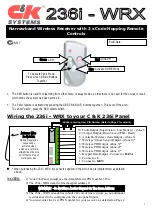
Small Wonder Labs
PSK-20 Transceiver Kit 03/09/10
2000
2
THE FINE PRINT:
There are lots of small parts in this kit. With many of
us getting older, this may prove troublesome. I highly
recommend a magnifying glass or close-up glasses to
check all solder joints and component codes.
THE OTHER FINE PRINT:
If you encounter conflicts between various sections of
this document, contact me for a resolution. The
following order of precedence applies:
•
Schematic (most trustworthy)
•
Parts list
•
Pictorial
•
grouped assembly text
•
Everything else
"This manual vs. QST":
This manual and even the schematic may
change as I find a better way to do things. The
parts we've supplied reflect this manual rather
than the
QST
article. Put aside the
QST
and follow
what you find in these pages. Understood?
TOOLS:
You'll need the following tools:
-Soldering iron- ~25W
- 60/40 solder, small dia.
-Diagonal cutters
-Needle-nose pliers
-Small slot screwdriver
-Wire-strippers (recommended)
-Tweezers (recommended)
TEST EQUIPMENT:
-
Multimeter
PSK-20 Power Requirements
.
The PSK-20 is designed to operate with a minimum
supply voltage of approximately 10V. A power supply
capable of delivering a minimum of 1 Amp at 12-14
Volts DC is recommended. Maximum recommended
supply voltage is 15VDC.
FIRST THINGS FIRST -
-
Stuff worth knowing!
COLOR CODES:
Resistor color codes are given in the parts list.
Radio Shack's Color-Code Guide, #271-1210, or the
ARRL Handbook will help. If you're not sure, verify
the resistor values with a multimeter before installing.
For what it's worth, roughly 8% of the male
population is red/green color blind. If you're one of
these, you should be verifying all resistors with a
multimeter before installing them.
The PSK-20 board is double-sided and all holes on
the board are plated-through. This means that you do
not need to solder on the top side of the board.
SOLDERING SKILLS
Hopefully this isn't your first experience with a
soldering iron. If it is, though, or this is your first
solid-state project, here are some tips to ensure your
success:
- Soldering Iron:
Use a small iron in the 25-watt class (such as a Radio
Shack #64-2070) and keep the tip clean. Use a
moistened sponge or paper towel to clean the tip
periodically as you work.
Apply only as much heat as is needed to get a good
joint. A small vise to hold the printed-circuit board
may make soldering easier.
Touch the soldering iron tip to the PC board trace and
the component lead simultaneously. Within a second
or two, apply solder and you'll see the solder flow onto
the junction. Withdraw the solder and then the
soldering iron.
Avoid the temptation to load solder onto the joint
until no more will fit! This is an invitation for trouble,
as solder bridges may form across the closer trace
separations. Here's what the correct and incorrect joint
treatments look like:



































